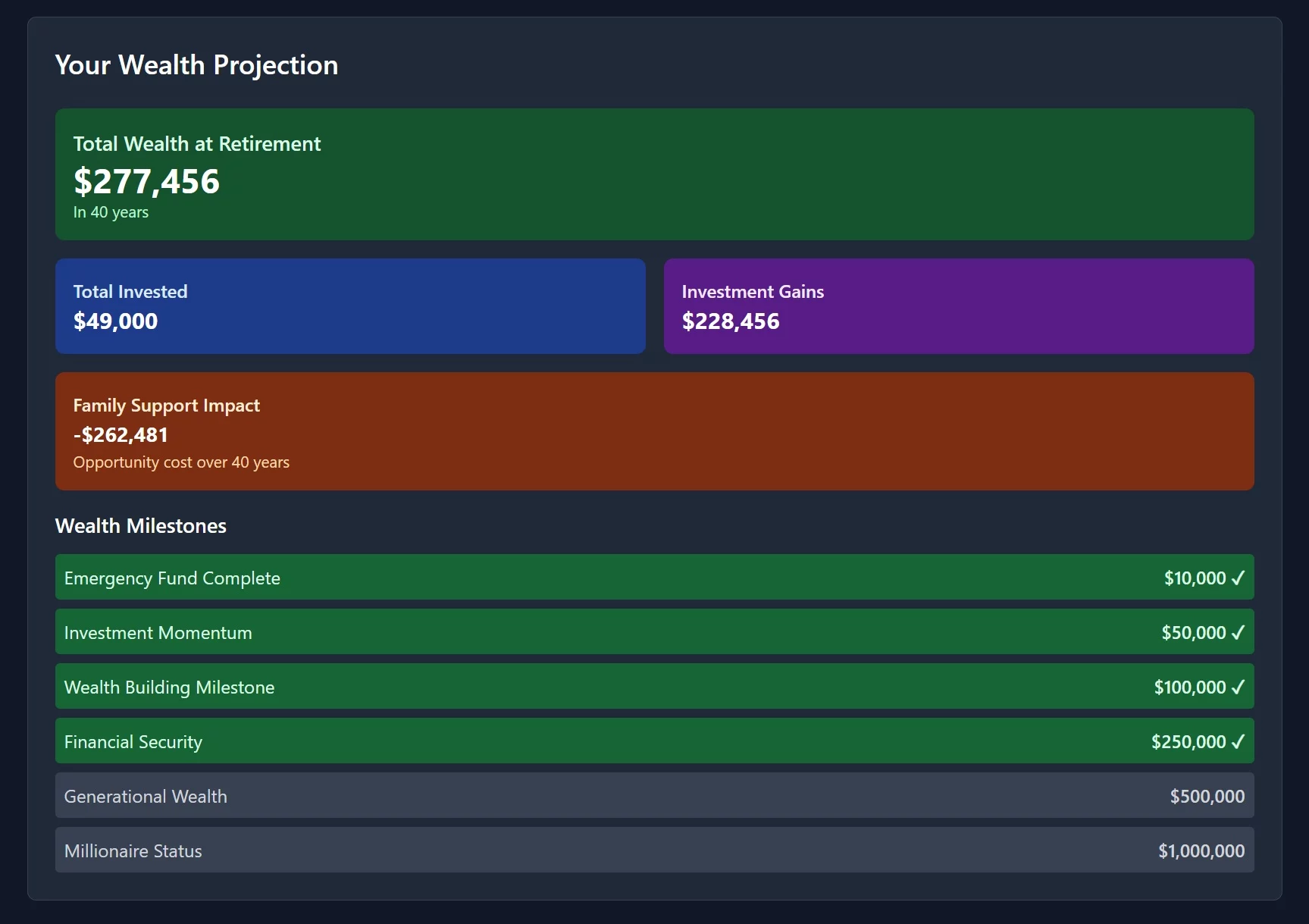I began trading in 2015 and started coaching in 2019. Minority communities face unique barriers that require targeted wealth-building strategies. Furthermore, traditional financial advice often ignores systemic challenges that impact investment success. Therefore, this guide addresses specific obstacles while providing actionable solutions for building generational wealth.
👉 In this guide, you will learn:
- 🚧 How to overcome historical barriers that limit minority wealth accumulation
- 💰 Strategic approaches to investing with limited initial capital
- 📊 Community-based investment strategies that amplify individual success
- 🎯 How to navigate discrimination in financial services effectively
- 💡 Building wealth despite income gaps and educational barriers
- 📈 Investment vehicles specifically designed for underserved communities
- ⚖️ Balancing family obligations with personal wealth building
Minority investors encounter systemic barriers that majority investors rarely face. Additionally, wealth gaps created by historical discrimination require intentional strategies to overcome. However, modern investment tools can help bridge these disparities when used strategically.

Table of Contents
The Minority Wealth Gap Reality Check 📊
Minority communities face a complex web of financial challenges rooted in historical discrimination. First, median household wealth for Black families remains just 10% of white family wealth. Moreover, Hispanic families hold only 12% of white family wealth on average. Meanwhile, these gaps persist despite educational and income improvements.
Systemic barriers affecting minority wealth building:
- 💸 Lower homeownership rates reducing primary wealth accumulation
- 🏦 Limited access to traditional banking and investment services
- 📉 Higher rates of predatory lending targeting minority communities
- 🏢 Employment discrimination affecting career advancement and salaries
- 📚 Reduced access to financial education and investment knowledge
- 👨👩👧👦 Extended family financial obligations limiting personal savings
However, minority investors also possess unique advantages often overlooked. Additionally, community support networks can amplify individual investment success. Furthermore, cultural values around family and community create opportunities for collective wealth building.
Minority community advantages to leverage:
- 🤝 Strong family and community support networks
- 💡 Entrepreneurial mindset and business creation skills
- 🌍 Cultural connections enabling global investment opportunities
- 📊 Growing purchasing power and market influence
- 🎯 Motivation to break generational poverty cycles
Smart minority investors recognize both challenges and opportunities. Therefore, they develop strategic approaches that work within existing systems while building alternative pathways to wealth.
Breaking Down Investment Barriers 🚧
Traditional financial services often create barriers for minority investors. Furthermore, minimum investment requirements and complex fee structures can exclude lower-income families. Additionally, geographic redlining limits access to quality financial advisors and services.
Access and Education Barriers
Limited Financial Literacy Programs Many communities lack accessible financial education targeting minority-specific challenges. Furthermore, generic investment advice fails to address cultural and economic realities. Additionally, language barriers can prevent non-English speakers from accessing quality information.
Breaking education barriers requires targeted approaches:
- 📚 Seek culturally relevant financial education programs
- 🤝 Join minority-focused investment clubs and community groups
- 💻 Access free online resources from diverse financial educators
- 🎯 Find mentors who understand your cultural and economic background
Discrimination in Financial Services Studies consistently show minority investors receive inferior service from financial advisors. Moreover, they’re often steered toward higher-fee products or conservative investments. Additionally, loan approvals and interest rates frequently disadvantage minority applicants.
Overcoming service discrimination:
- 🔍 Research advisor credentials and fee structures thoroughly
- 📊 Compare multiple providers before making decisions
- 💰 Use fee-only advisors who charge transparent rates
- 🏦 Consider minority-owned financial institutions and advisors
Minimum Investment Barriers
Traditional Account Minimums Many investment firms require substantial minimum investments that exclude middle and lower-income families. Furthermore, advisory services often require $100,000+ to access professional management.
Overcoming minimum barriers:
- 📱 Use commission-free brokerages with no account minimums
- 💰 Start with fractional shares of expensive stocks
- 🤖 Consider robo-advisors with low minimums
- 📈 Build accounts gradually through consistent small contributions
Strategic Approaches for Limited Capital 💰
Minority investors often begin with smaller amounts than traditional advice assumes. Therefore, strategies must maximize limited resources while building toward larger goals. Furthermore, every dollar invested early provides maximum compound growth benefit.
Micro-Investing Strategies
Starting with Small Amounts Modern technology enables investing with as little as $1. Furthermore, fractional shares allow diversification even with minimal capital. Additionally, automatic round-up programs turn spare change into investments.
Micro-investing implementation:
- 📱 Use apps that round up purchases and invest the difference
- 💰 Start with $25-50 monthly automatic investments
- 📊 Focus on low-cost broad market index funds
- 🎯 Gradually increase contributions as income grows
Building Emergency Funds First Emergency funds prevent forced investment liquidations during crises. Furthermore, minority families often face higher rates of income volatility. Additionally, limited family wealth means less external support during emergencies.
Emergency fund priorities:
- 💰 Start with $500 minimum for basic emergencies
- 🏦 Build to one month expenses before aggressive investing
- 📈 Use high-yield savings for emergency fund growth
- 🚫 Separate emergency funds from investment accounts completely
Community Investment Approaches
Investment Clubs and Group Strategies Investment clubs enable pooled resources and shared knowledge. Moreover, they provide accountability and support for consistent investing. Additionally, group buying power can access investments with higher minimums.
Community investment benefits:
- 🤝 Shared research and education costs
- 💰 Pooled resources access better investment options
- 📚 Group learning accelerates financial education
- 🎯 Accountability improves investment consistency
Family Wealth Building Strategies Extended family networks can coordinate wealth building efforts. Furthermore, family members can share resources and knowledge effectively. Additionally, collective strategies can overcome individual resource limitations.
Family coordination strategies:
- 👨👩👧👦 Coordinate 529 college savings across family members
- 🏠 Pool resources for real estate investments
- 📊 Share investment research and recommendations
- 💰 Create family emergency funds for crisis support
Building Wealth Despite Income Gaps 📈
Income disparities require adjusted wealth building strategies that account for starting disadvantages. Furthermore, minority investors often cannot rely on inherited wealth or family financial support. Therefore, strategies must emphasize aggressive growth and smart resource allocation.
Maximizing Tax-Advantaged Accounts
Retirement Account Prioritization Tax-advantaged accounts provide the biggest benefit for lower-income investors. Moreover, employer matching represents immediate 100% returns. Additionally, tax savings become more valuable as income grows.
Account priority order for minority investors:
- 🏢 Employer 401(k) match (immediate 100% return)
- 💰 Roth IRA for tax-free growth ($7,000 limit)
- 🔄 Additional 401(k) contributions for tax deferral
- 📊 HSA if available (triple tax advantage)
- 🎯 Taxable accounts for flexibility
Roth IRA Advantages for Minority Investors Roth IRAs provide unique benefits for investors expecting future income growth. Furthermore, contributions can be withdrawn penalty-free for emergencies. Additionally, tax-free growth becomes extremely valuable over decades.
Roth IRA optimization:
- 💰 Prioritize Roth contributions when income is lower
- 📈 Withdraw contributions (not gains) for emergencies if needed
- 🎯 No required distributions allow wealth transfer to heirs
- 🔄 Convert traditional IRAs during low-income years
Aggressive Growth Strategies
High-Growth Investment Allocation Minority investors often need aggressive growth to overcome starting disadvantages. Furthermore, longer time horizons justify higher risk tolerance. Additionally, systematic investing reduces timing risk.
Aggressive allocation strategy:
- 📊 90-100% stocks for investors under 40
- 🌍 Include international diversification (25-30%)
- 📈 Small-cap exposure for enhanced growth potential
- 💰 Minimize bonds until approaching retirement
Alternative Wealth Building Paths Traditional investment advice assumes steady employment and income growth. However, minority entrepreneurs often build wealth through business ownership. Additionally, real estate can provide both income and appreciation.
Alternative wealth strategies:
- 🏢 Small business ownership and reinvestment
- 🏠 House hacking and rental property investment
- 💼 Side hustles and multiple income streams
- 📚 Skill development for career advancement
Navigating Discrimination in Financial Services 🎯
Minority investors must navigate ongoing discrimination while building wealth. Furthermore, awareness of these issues helps avoid costly mistakes. Additionally, strategic selection of financial partners improves outcomes.
Choosing Financial Partners
Fee Transparency and Fairness Minority investors often pay higher fees for inferior service. Therefore, fee transparency becomes crucial for fair treatment. Furthermore, understanding fee structures prevents predatory practices.
Fee evaluation criteria:
- 💰 Compare expense ratios across similar investment options
- 📊 Understand all fees including trading costs and advisory fees
- 🔍 Research fee structures before opening accounts
- ⚖️ Avoid high-fee products targeting inexperienced investors
Cultural Competency in Advisors Financial advisors who understand minority community challenges provide better service. Moreover, they can offer strategies that account for cultural and family obligations. Additionally, diverse advisors often relate better to minority client needs.
Advisor selection factors:
- 🤝 Seek advisors with diverse client bases
- 📚 Look for cultural competency training and certifications
- 💡 Find advisors who understand extended family obligations
- 🎯 Choose fee-only advisors to avoid conflicts of interest
Building Financial Networks
Professional Development for Investment Success Career advancement directly impacts investment capacity. Furthermore, minority professionals often need intentional networking for advancement. Additionally, higher income enables more aggressive investment strategies.
Career advancement strategies:
- 📚 Invest in professional development and certifications
- 🤝 Build networks within your industry and community
- 💼 Seek mentorship from successful minority professionals
- 🎯 Negotiate salary increases and promotions strategically
Community Resource Sharing Minority communities can share resources to overcome individual limitations. Furthermore, collective knowledge and support improve everyone’s outcomes. Additionally, community accountability encourages consistent investing.
Resource sharing approaches:
- 💡 Share investment research and recommendations
- 📚 Organize financial education workshops and seminars
- 🤝 Create investment clubs and accountability groups
- 💰 Pool resources for professional advisory services
Investment Vehicles for Underserved Communities 🏦
Specialized investment options serve minority communities more effectively than traditional approaches. Furthermore, these vehicles often address specific community needs and challenges. Additionally, they can provide both financial returns and community impact.
Community Development Financial Institutions (CDFIs)
CDFI Investment Opportunities CDFIs focus on serving underbanked communities with investment and lending services. Moreover, they often provide better terms and more flexible requirements. Additionally, investing in CDFIs supports community development.
CDFI advantages:
- 🏦 Better service for minority and low-income customers
- 💰 Competitive rates with community focus
- 🎯 Loan products designed for underserved populations
- 🤝 Reinvestment in local community development
Credit Union Benefits Credit unions often provide better service and rates for minority members. Furthermore, they operate as member-owned cooperatives. Additionally, many credit unions serve specific ethnic or professional communities.
Credit union advantages:
- 💰 Higher savings rates and lower loan rates
- 🤝 Member-owned structure aligns interests
- 📊 Often better financial education programs
- 🏦 More flexible lending criteria for members
ESG and Impact Investing
Socially Responsible Investment Options ESG (Environmental, Social, Governance) investing allows alignment of values with investments. Moreover, many ESG funds focus on diversity and inclusion. Additionally, impact investing can generate both returns and positive social change.
ESG investment benefits:
- 🌍 Align investments with personal and community values
- 📈 Many ESG funds perform competitively with traditional options
- 🎯 Support companies with diverse leadership and practices
- 💡 Invest in solutions for community challenges
Community Investment Funds Specialized funds invest in minority-owned businesses and community development. Furthermore, these investments can generate competitive returns while supporting community growth. Additionally, they often provide more accessible minimum investments.
Balancing Family Obligations with Wealth Building ⚖️
Minority families often face extended financial obligations that impact personal wealth building. Furthermore, cultural values around family support can conflict with individual investing. Therefore, strategies must balance competing priorities effectively.
Managing Extended Family Financial Support
Setting Boundaries on Family Support Unlimited family financial support can derail personal wealth building. However, completely refusing support may damage important relationships. Therefore, structured approaches balance both needs effectively.
Family support boundaries:
- 💰 Set specific budgets for family financial assistance
- 🎯 Focus on emergencies rather than ongoing support
- 📚 Provide financial education instead of direct money transfers
- ⚖️ Maintain your own emergency fund before helping others
Teaching Family Members to Invest Helping family members build wealth creates stronger overall family financial security. Moreover, shared knowledge and accountability improve everyone’s outcomes. Additionally, coordinated family wealth building multiplies individual efforts.
Family education strategies:
- 📚 Share investment knowledge and resources with family
- 🤝 Create family investment clubs or accountability groups
- 💰 Help family members open retirement and investment accounts
- 🎯 Coordinate major financial decisions for maximum benefit
Generational Wealth Transfer
Breaking Cycles of Financial Instability Building personal wealth enables breaking generational poverty cycles. Furthermore, financial stability provides security for both current and future generations. Additionally, early wealth building creates time for compound growth.
Generational wealth strategies:
- 💰 Build emergency funds to avoid debt cycles
- 📈 Invest consistently for long-term compound growth
- 🏠 Consider homeownership for wealth building and stability
- 📚 Teach children financial literacy from early ages
Creating Legacy Investment Accounts Custodial investment accounts enable wealth building for children. Moreover, early investing provides maximum compound growth opportunity. Additionally, these accounts teach investment principles to next generation.
Legacy account options:
- 👶 Custodial investment accounts (UTMA/UGMA)
- 🎓 529 education savings plans for college costs
- 📊 Roth IRAs for children with earned income
- 💰 Life insurance with cash value for legacy planning
Common Mistakes to Avoid 🚨
Understanding typical mistakes helps minority investors optimize their strategies. Furthermore, these mistakes can significantly impact long-term wealth building success. Therefore, awareness and prevention prove crucial for financial progress.
Investment Mistakes
Keeping Too Much in Low-Yield Savings Risk aversion often leads to excessive cash holdings that lose purchasing power. However, inflation erodes savings value over time. Therefore, balanced approaches maintain emergency funds while investing for growth.
Cash optimization strategies:
- 💰 Keep 3-6 months expenses in high-yield savings
- 📈 Invest additional savings for inflation protection
- 🏦 Use money market accounts for intermediate-term goals
- 📊 Review cash allocation regularly as income grows
Following Get-Rich-Quick Schemes Minority communities are often targeted by investment scams promising quick wealth. Furthermore, desperation to overcome wealth gaps makes these schemes appealing. Additionally, limited financial education makes recognition difficult.
Scam protection strategies:
- 🚨 Avoid investments promising guaranteed high returns
- 🔍 Research all investment opportunities thoroughly
- 📚 Stick to established, regulated investment options
- 🤝 Seek advice from credentialed financial professionals
Behavioral Mistakes
Emotional Investment Decisions Market volatility can trigger emotional buying and selling decisions. Furthermore, minority investors may feel more pressure to avoid losses. Additionally, limited experience can lead to poor timing decisions.
Emotional control strategies:
- 📊 Develop systematic investment plans and stick to them
- 🎯 Focus on long-term goals rather than short-term volatility
- 💰 Use automatic investing to remove emotional decisions
- 📚 Continue education to build confidence and knowledge
FAQs 🤔
Q: How much money do I need to start investing as a minority investor? A: You can start with as little as $1 using fractional shares and commission-free brokerages. Focus on consistency rather than large initial amounts, and prioritize building emergency funds first.
Q: How do I find financial advisors who understand minority community challenges? A: Seek advisors with diverse client bases, cultural competency training, and fee-only compensation structures. Consider minority-owned financial firms and ask for references from other minority clients.
Q: Should I help family members financially before investing for myself? A: Build your own emergency fund and capture employer 401(k) matching first. Then set specific budgets for family assistance while maintaining consistent personal investing.
Q: How do I overcome discrimination in financial services? A: Research providers thoroughly, compare fees and services across multiple firms, and document any discriminatory treatment. Consider minority-owned financial institutions and fee-only advisors.
Q: What’s the best investment strategy for overcoming wealth gaps? A: Maximize tax-advantaged accounts, maintain aggressive growth allocation while young, and invest consistently regardless of market conditions. Focus on low-cost index funds for broad diversification.
Q: How do I balance investing with extended family obligations? A: Set clear boundaries on family financial support, teach family members to invest, and coordinate wealth building strategies when possible. Maintain your own financial stability first.
Conclusion
Minority investors face unique challenges requiring targeted strategies and determination. Therefore, understanding systemic barriers enables development of effective workarounds. Furthermore, leveraging community strengths and modern investment tools can overcome historical disadvantages.
Success requires consistent investing despite obstacles, strategic selection of financial partners, and balanced approaches to family obligations. Additionally, aggressive growth strategies become essential for overcoming starting disadvantages.
Finally, building generational wealth requires breaking cycles of financial instability while teaching next generations essential financial skills and investment principles.

Hold a Master Degree in Electrical engineering from Texas A&M University.
African born – French Raised and US matured who speak 5 languages.
Active Stock Options Trader and Coach since 2014.
Most Swing Trade weekly Options and Specialize in 10-Baggers !
YouTube Channel: https://www.youtube.com/c/SuccessfulTradings
Other Website: https://237answersblog.com/
